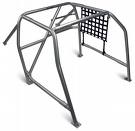Continuing on our rollcage discussion, how many points of attachment is enough? More is better is the usual train of thought, but more bars in the cage means more weight. And since acceleration is determined by horsepower per pound of car, the more you weigh, the less you accelerate. So the right balance of enough cage to be safe and to keep the chassis rigid versus keeping the weight down can be a tricky one. The old days just started out with one hoop and two attachment points just behind the driver, also known as a roll-over-bar, or rollbar for short. This provided a little bit of rollover protection and essentially no collision protection. Next came a forward hoop located above the driver’s knees (basically behind the dashboard) with bars connecting the front and rear hoops, leaving four attachment points to the chassis. Side bars between the hoops, along the inside of the doors, added driver safety from side collisions. This added considerable lateral and longitudinal rigidity to the frame of the car. Less frame flex means a stronger frame, but now the portions of the frame forward and aft of the cage have to absorb all the chassis flex created by the cornering loads placed on it by the suspension (springs and swaybars). Frame cracking in areas between the suspension attachment points and the rollcage attachment points is not uncommon. Then racers added cage extensions and attachment points to the frame where the rear suspension and axle attached to absorb the rear chassis flex (six points). Further refinement added bars and attachment points to the forward suspension locations in order to reduce flex there (eight points). You would think that was enough, but for some cars that take a real beating, like rally cars, there are even ten and twelve point roll cages.
 A big problem with rollcages in small production cars is that they also take up a lot of room. Climb into a racecar for the first time and you realize that you have considerably less head, elbow, and leg room. Add a helmet and a five point seat harness, and it gets tight in a hurry. Proper rollcage design will put the tubing as close to the body panels as possible to increase the room for the driver, but anyone who has built a rollcage will tell you this job is easier said than done. Cutting and welding 360 degrees around a piece of tubing 1/2 an inch from a door hinge or floorboard is a tough task. One technique often used by fabricators is to just cut off the top of the car, build the cage, then weld the top of the car back on. This provides excellent results and should be highly considered. Having a snug fit between the tubing and the body panels also allows attachment plates to be welded in place between the two, further increasing chassis rigidity. Now you can see why a good quality, custom rollcage can easily take dozens of hours, and cost thousands of dollars, to build.
A big problem with rollcages in small production cars is that they also take up a lot of room. Climb into a racecar for the first time and you realize that you have considerably less head, elbow, and leg room. Add a helmet and a five point seat harness, and it gets tight in a hurry. Proper rollcage design will put the tubing as close to the body panels as possible to increase the room for the driver, but anyone who has built a rollcage will tell you this job is easier said than done. Cutting and welding 360 degrees around a piece of tubing 1/2 an inch from a door hinge or floorboard is a tough task. One technique often used by fabricators is to just cut off the top of the car, build the cage, then weld the top of the car back on. This provides excellent results and should be highly considered. Having a snug fit between the tubing and the body panels also allows attachment plates to be welded in place between the two, further increasing chassis rigidity. Now you can see why a good quality, custom rollcage can easily take dozens of hours, and cost thousands of dollars, to build.
Suspension, brakes, and steering make up the remaining components of a chassis. Many books have been written on each of these subjects alone, so there is no way to cover everything here, but we’ll try to discuss some ways to keep the performance up and the price down as we progress.
Leave a Reply